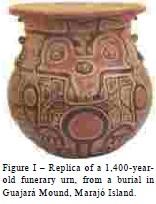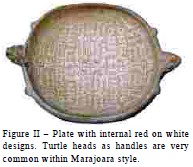Marajoara ceramics represent one of the most sophisticated styles of the prehistoric Americas and of the New World. The study of their intricate designs has demonstrated the development of an iconographic language, communicating ideas based on mythology, social roles, gender and status. Most of the objects date back to AD 600 – 1200. The ceramics are extremely resistant, and the decorative techniques are quite complex. About 15 finishing techniques are known, which combine red and white wash, incision1, excision2 and painting in various ways. Also, modeled animals and human figurines are used as handles and appliqués on plates, bowls, stools, and vessels. The repertory of vessel shapes and objects is numerous. It is possible to find funerary urns, vases, bowls, bottles, toasters, plates, stools, and adornments of various sizes and decoration.
Within the Marajoara style, there are some substyles distributed over different regions on Marajó Island. Painted urns shaped as female owls are found at the Anajás River area, while incised feminine urns decorated with snake patterns are characteristic of the Arari Lake region. The distribution of styles was likely related to group affiliation. Consequently, art can be used to characterize, differentiate and understand relations between social groups who are geographically apart, but culturally related.
Presently, ceramics inspired on Marajoara style is produced for sale in the State of Pará, Brazil. The potters are in most cases descendants of Indians (not Marajoara Indians) and learned to make pottery with their mothers. In Icoaraci, Mestre Cardoso started a tradition of making replicas of Marajoara ceramics for sale, and taught others to do so. It has helped to preserve and disseminate the memory of indigenous societies and their crafts and it is important in promoting tourism in the region.
1 to excise – to remove by, or as if by, cutting out.
2 to incise – to cut designs into a surface, to engrave.
Internet: <http://www.marajoara.com> (with adaptations).




